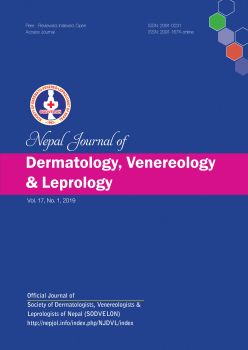Patch Testing In Nepalese Population: A Single Center Study From Kathmandu, Nepal
DOI:
https://doi.org/10.3126/njdvl.v17i1.23118Keywords:
Allergens, Dermatitis, Allergic Contact, Eczema, Nickel sulfateAbstract
Introduction: Patch testing is a diagnostic tool used in investigation to identify specific allergens in allergic contact dermatitis (ACD). It helps find the prevalence and the trends of contact sensitization in the community.
Objective: To report the two year patch test results from a central hospital in Kathmandu.
Materials and Methods: Consecutive consenting patients of suspected ACD were patch tested with an Indian standard Series (Systopic) from June 2014 to August 2016.
Results: Out of 141 patients tested, 89 were female (63.12%) and 52 were male (36.88%). Hand eczema was the commonest pattern (53 patients) followed by persistent and recurrent eczema (44 patients) and face eczema (25 patients). Fifty- five patients (39%) had at least 1 positive allergic reaction. Among these, 16.31% were male and 22.70% were female. The most common allergen was nickel sulfate (19.9%) followed by fragrance mix (7.8%) and paraphenyldiamine (PPD) (6.4%). Out of total positive cases 27 (21 females and 6 males) had shown strong positive reactions (++). The Nickel Sulfate was responsible in majority of cases (18/27 cases). Farmers had the highest (57.14%) rate of positive allergic reactions followed by housewives (39.62%). According to the regional eczema, patients with persistent and recurrent eczema of different parts of body had the highest rate of positive allergic reactions (47.72%). Almost half of patient with facial eczema (40%) had positive patch test.
Conclusion: Larger studies are required in the different parts of the country to find a more accurate data regarding the sensitization pattern in Nepalese population.
Downloads
Downloads
Published
How to Cite
Issue
Section
License
Copyright on any research article is transferred in full to Nepal Journal of Dermatology, Venereology & Leprology upon publication. The copyright transfer includes the right to reproduce and distribute the article in any form of reproduction (printing, electronic media or any other form).




